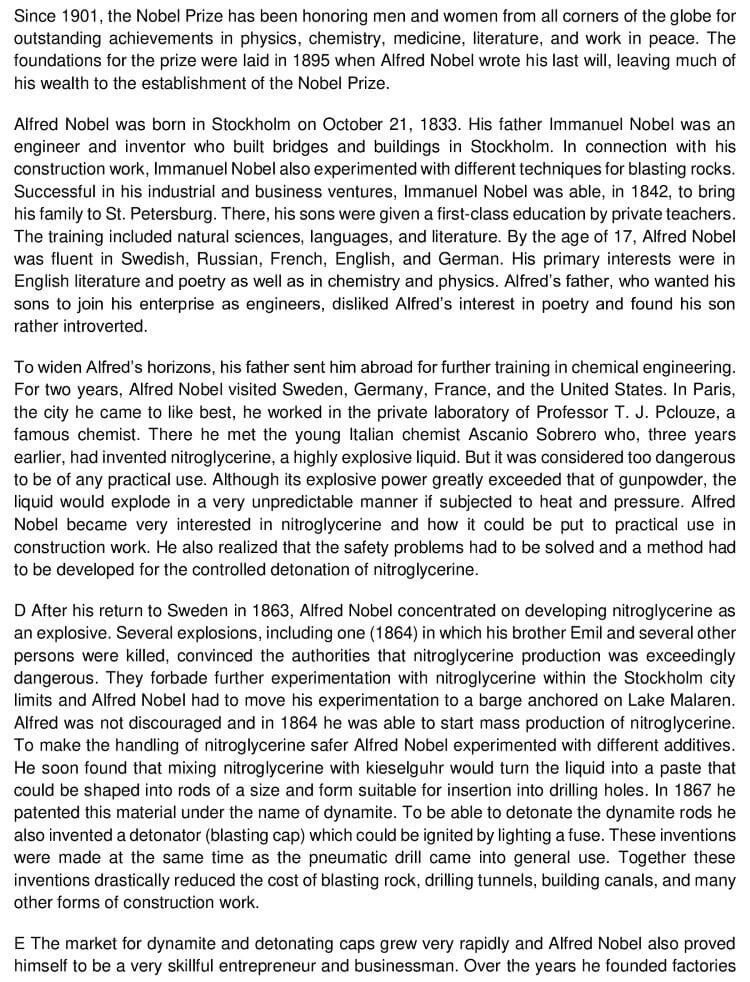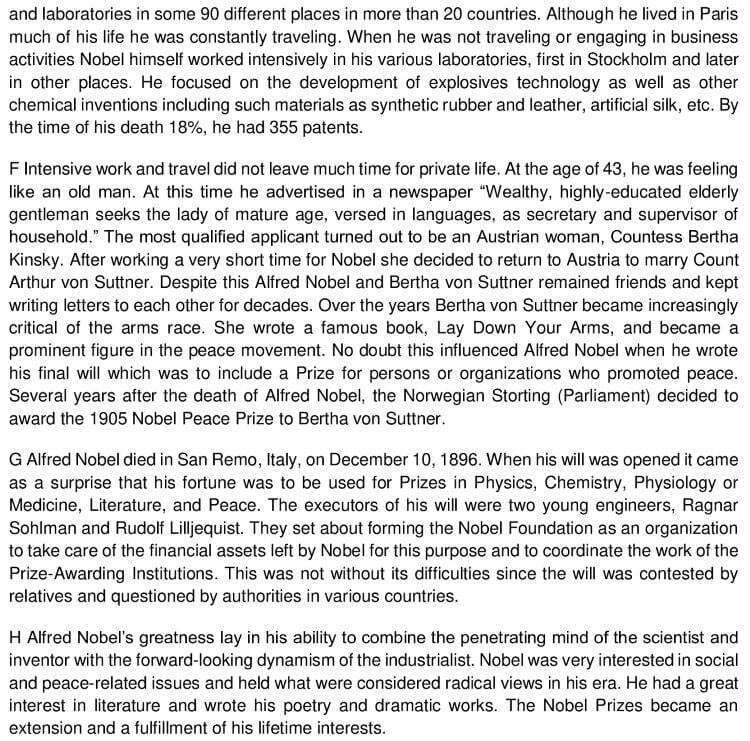Alfred Nobel - IELTS Reading Answers
7 min read
Updated On
-
Copy link
Find 'Alfred Nobel' IELTS Reading answers and practice the test as well!
Table of Contents

Limited-Time Offer : Access a FREE 10-Day IELTS Study Plan!
The IELTS Academic Reading Module of the IELTS can be the top-scoring category, with diligent practice. To achieve the best results in this section, you must understand how to approach and answer the different Question types in the Reading Module. By solving and reviewing Sample Reading Questions from past IELTS Reading recent actual tests., you can ensure that your Reading skills are up to the mark.
Reading Passage
Alfred Nobel
The man behind the Nobel Prize


Questions 1-6 (Alfred Nobel reading answer)
Do the following statements agree with the information given in Reading Passage 1?
In boxes 1-6 on your answer sheet, write
TRUE if the statement is true
FALSE if the statement is false
NOT GIVEN if the information is not given in the passage
1 The first Nobel Prize was awarded in 1895.
2 Nobel’s father wanted his son to have a better education than what he had had.
3 Nobel was an unsuccessful businessman.
4 Bertha von Suttner was selected by Nobel himself for the first peace prize.
5 The Nobel Foundation was established after the death of the Nobel
6 Nobel’s social involvement was uncommon in the 1800s.
Questions 7-13
Complete the notes below using NO MORE THAN TWO WORDS from the passage.
Write your answers in boxes 7-13 on your answer sheet.
Education:
Having accumulated a great fortune in his business, Nobel’s father determined to give his son the best education and sent him abroad to be trained in 7………………… during Nobel’s study in Paris, he worked in a private laboratory, where he came in contact with a young engineer 8…………..…… and his invention nitroglycerine, a more powerful explosive than 9…………..………
Benefits in construction works:
Nobel became interested in this new explosive and experimented on it. But nitroglycerine was too dangerous and was banned for experiments within the city of 10………………. So Nobel had to move his experiments to a lake. To make nitroglycerine easily usable, Nobel invented dynamite along with 11…………………. while in the meantime 12………………. became popular, all of which dramatically lowered the 13……………..…. of construction works.
Reading Answers
1 Answer: False
Question type: True/False/ Not Given
Answer location: Paragraph A
Answer explanation: The introductory lines of paragraph A states that since 1901, the Nobel Prize has been honoring men and women from all corners of the globe for outstanding achievements in physics, chemistry, medicine, literature, and work in peace. The foundations for the prize were laid in 1895 when Alfred Nobel wrote his last will, leaving much of his wealth to the establishment of the Nobel Prize. These lines indicate that the first Nobel prize was awarded from the year 1901 onwards. Only 1lin 1895, Alfred Nobel left much of his wealth to set up the Nobel Prize. Thus, the statement contradicts the information, so, the answer is False.
2 Answer: Not Given
Question type: True/ False/ Not Given
Answer location: Paragraph B, last line
Answer explanation: In the last line of paragraph B, it is mentioned that Alfred’s father wanted his sons to join his enterprise as engineers, however, he disliked Alfred’s interest in poetry and found his son rather introverted. However, there’s no reference to the fact that Nobel’s father wanted his son to have a better education than what he did. Thus, the answer is Not Given.
3 Answer: False
Question type: True/ False/ Not Given
Answer location: Paragraph E
Answer explanation: The initial lines of paragraph E states that the market for dynamite and detonating caps grew very rapidly and Alfred Nobel also proved himself to be a very skillful entrepreneur and businessman. We can understand from these lines that when the market for dynamite and detonating caps grew, Alfredo proved himself to be a very skilled entrepreneur and businessman. Thus, the statement contradicts the information, so, the answer is False.
4 Answer: False
Question type: True/ False/ Not Given
Answer location: Paragraph F, last line
Answer explanation: We can understand from the last line of paragraph F that several years after the death of Alfred Nobel, the Norwegian Storting (Parliament) decided to award the 1905 Nobel Peace Prize to Bertha von Suttner. Thus, it is clear that Suttner was not selected by Nobel for the first peace prize. Hence, the statement contradicts the information, so, the answer is False.
5 Answer: True
Question type: True/ False/ Not Given
Answer location: Paragraph G, line 3
Answer explanation: We can understand from the 3rd line of paragraph G that Ragnar Sohlman and Rudolf Lilljequist were the executors of Nobel’s will, who set about forming the Nobel Foundation as an organization to take care of the financial assets left by Nobel for this purpose and to coordinate the work of the Prize-Awarding Institutions. Thus, the statement agrees with the information, so, the answer is True.
6 Answer: Not Given
Question type: True/ False/ Not Given
Answer location: Paragraph H
Answer explanation: We come to know from paragraph H that Nobel was very much interested in social and peace-related issues and held what were considered radical views in his era. Thus, there’s no reference to the fact that the social involvement of Nobel was uncommon in the 1800s. Hence, the answer is Not Given.
7 Answer: Chemical Engineering
Question type: Note Completion
Answer location: Paragraph C
Answer explanation: The introductory lines of paragraph C states that to widen Alfred’s horizons, his father sent him abroad for further training in chemical engineering. These lines indicate that Nobel’s father was determined to give his son the best education, so he sent him abroad to be trained in chemical engineering. Thus, the answer is Chemical Engineering.
8 Answer: Ascanio Sobrero
Question type: Note Completion
Answer location: Paragraph C
Answer explanation: Paragraph C states that in Paris, the city Nobel came to like best, he worked in the private laboratory of Professor T. J. Pclouze, a famous chemist. There he met the young Italian chemist Ascanio Sobrero who, three years earlier, had invented nitroglycerine, a highly explosive liquid. These lines suggest that when Nobel was working in a private laboratory in Paris, he came in contact with a young engineer, Ascanio Sobrero, with whom he invented Nitroglycerine. Hence, the answer is Ascanio Sobrero.
9 Answer: Gunpowder
Question type: Note Completion
Answer location: Paragraph C, line 6
Answer explanation: The 6th line of paragraph C reveals that although its explosive power greatly exceeded that of gunpowder, the liquid would explode in a very unpredictable manner if subjected to heat and pressure. These lines indicate that despite its explosive power exceeding that of gunpowder, the liquid could explode in a very unpredictable manner. Thus, nitroglycerine is a more powerful explosive than gunpowder. Hence, the answer is gunpowder.
10 Answer: Stockholm
Question type: Note Completion
Answer location: Paragraph D, line 2
Answer explanation: The 2nd line of paragraph D states that several explosions, including one (1864) in which his brother Emil and several other persons were killed, convinced the authorities that nitroglycerine production was exceedingly dangerous. They forbade further experimentation with nitroglycerine within the Stockholm city limits. These lines indicate that due to its powerful explosiveness, nitroglycerine and its experimentation were banned within the limits of Stockholm. Thus, the answer is Stockholm.
11 Answer: Detonator
Question type: Note Completion
Answer location: Paragraph D, line 10
Answer explanation: The 10th line of paragraph D states that to be able to detonate the dynamite rods he also invented a detonator (blasting cap) which could be ignited by lighting a fuse. We can deduce from these lines that to make nitroglycerine easily usable, Nobel invented dynamite along with a detonator (blasting caps). Thus, the answer is a detonator.
12 Answer: pneumatic drill
Question type: Note Completion
Answer location: Paragraph D, line 11
Answer explanation: In the 11th line of paragraph D, it is mentioned that these inventions were made at the same time as the pneumatic drill came into general use. These lines suggest that when the detonator was invented, pneumatic drills became popular. Hence, the answer is pneumatic drills.
13 Answer: cost
Question type: Note Completion
Answer location: Paragraph D, last line
Answer explanation: The last line of paragraph D states that together these inventions drastically reduced the cost of blasting rock, drilling tunnels, building canals, and many other forms of construction work. We can understand that the invention of the detonator and the popularity of pneumatic drills dramatically lowered the cost of construction works. Thus, the answer is cost.
Check More IELTS Reading Answers
Practice IELTS Reading based on question types

Start Preparing for IELTS: Get Your 10-Day Study Plan Today!
Recent Articles

Nehasri Ravishenbagam

Haniya Yashfeen

Haniya Yashfeen

Haniya Yashfeen




Post your Comments